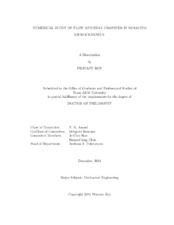| dc.description.abstract | Investigation of fluid flow and heat transfer in rotating microchannels is important for centrifugal microfluidics, which has emerged as an advanced technique in biomedical applications and chemical separations. The centrifugal force and the Coriolis force, arising as a consequence of the microchannel rotation, change the flow pattern significantly from the symmetric profile of a non-rotating channel. A successful design of a centrifugal microfluidic device depends on effectively regulating these forces in rotating microchannels. Although a large number of experimental studies have been performed in order to demonstrate the applications of centrifugal microfluidics in various fields, a systematic study on the effect of rotation, channel aspect ratio, and wall boundary conditions on the fluid flow and heat transfer phenomena in rotating microchannels has not yet been conducted.
During the present study, pressure-based finite volume solvers in both staggered and collocated grids were developed to solve steady and unsteady, incompressible Navier-Stokes equations. The serial solver in collocated grid was parallelized using a Message Passing Interface (MPI) library. In order to accelerate the convergence of the collocated finite volume solver, a non-linear multi-grid method was developed. The parallel performances of the single and multi-grid solvers were tested on a two-dimensional lid driven cavity flow. High fidelity benchmark solution to a lid driven cavity flow problem in a 1024 x 1024 grid was presented for a range of Reynolds numbers. Parallel multigrid speedup as high as three orders of magnitude was achieved for low Reynolds number flows. In addition, the optimal multigrid efficiency was validated.
The fluid flow in a rotating microchannel was modeled as a steady, laminar in compressible flow with no slip and slip boundary conditions. For no slip boundary condition, critical values of parameters that determine the extent of the centrifugal force and the Coriolis force were identified. The critical aspect ratio (=width/height) that causes the optimal mixing of two liquids was found to be 1.0. For liquid slip boundary condition, the effect of rotation on liquid slip flow in rotating microchannels with hydrophobic and superhydrophobic surfaces was studied. New correlations for friction relation (fRe) as a function of slip length (λ) and rotational Reynolds number (Reω) were proposed. It was also found that, the liquid slip can increase or decrease the heat transfer depending on the secondary flow effect and the aspect ratio of the microchannel.
The microscale effects, such as surface tension and contact angle boundary condition, were included in the modeled problem. A level set method was applied to incorporate these microscale effects, which will enable us to investigate the unsteady nature of the liquid meniscus during two-phase flow simulations. | en |


